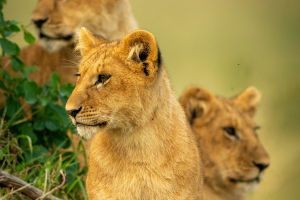Elephants are the largest living terrestrial mammals, with developed senses of smell and hearing, but poor vision. Its proboscis functions as arms and fingers. Elephant's huge auricle not only helps to hear sound, but also has the function of dissipating heat.
African savannah elephants are huge and have thick and long teeth. Both males and females have tusks. African forest elephants are similar in appearance to savannah elephants, except that they are much smaller, with long tusks facing downwards, and they are not bent much, almost parallel to their legs.
The most notable feature of Asian elephants is that there are two bumps on the top of their heads, and only male elephants have tusks. African elephants have larger ears and Asian elephants have smaller ears. Let's learn more about them.
1. African Elephant
African elephants have strong family bonds, and they live closely in matrilineal family groups. After the baby elephant is born, the whole family is responsible for raising and caring for it.
They are eating for most of the day! Elephants are herbivores and feed on grass, leaves, bark, fruit and a wide variety of plant foliage. Over 300 pounds of food can be eaten in a day.
For most of an elephant's life, tusks are constantly growing. Despite the international ban on ivory sales, elephants are still subject to poaching as the illegal market for ivory remains high.
Elephants spray water on their bodies with their trunks to cool down. They also use their noses as a snorkel when wading into rivers.
African elephants have very strong trunks, with more than 40,000 muscles and tendons, and can lift more than 400 pounds at a time. The sensitive tip of the African elephant trunk has two finger-like protrusions that can be used to "grab" very small objects.
2. Asian Elephant
Asian elephants live in tropical forests, jungles or grasslands. They like to live in groups, led by a female elephant, have no fixed habitat, and move during the day. Asian elephants are sensitive to smell and hearing, and have poor eyesight. They like to bathe in water when it is hot. They feed on weeds, leaves, bamboo leaves, wild fruits, etc.
Asian elephants have a gentle temperament and are relatively easy to tame. The breeding period of Asian elephants is not fixed, the gestation period is 20-22 months, and one cub is born each time. Their lifespan is 60-70 years.
There is only one species of Asian elephant, also called Indian elephant. It is distributed in South and Southeast Asia. There is a finger-like protrusion on the nose. Their skulls have two protrusions and their backs are arched.
In addition, Malaysia has a subspecies of Asian elephants, the pygmy elephant, which is even smaller. There is a subspecies of African elephants in Namibia, desert elephants. The pads under their feet become larger, and they are more suitable for water-deficient life. They know how to save water and look for water sources in the desert.
3. Mammoth
Mammoths lived about 11,000 years ago and originated in Africa. They were distributed in the northern regions of Europe, Asia, and North America in the early Pleistocene. They could adapt to grasslands, forests, tundra snowfields and other environments.
A few species of mammoths are covered with long hair and have a thick layer of fat to keep out the cold. Unlike modern elephants, they did not live in the tropics or subtropics, but an ancient mammal that lived in the cold climate of the north.
They feed on grasses and beans in summer, and bushes and bark in winter, and live in groups. The last mammoths went extinct around 1670 BC.


